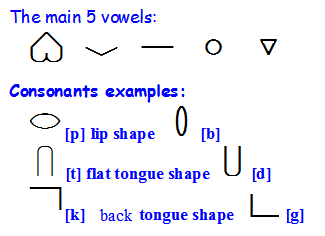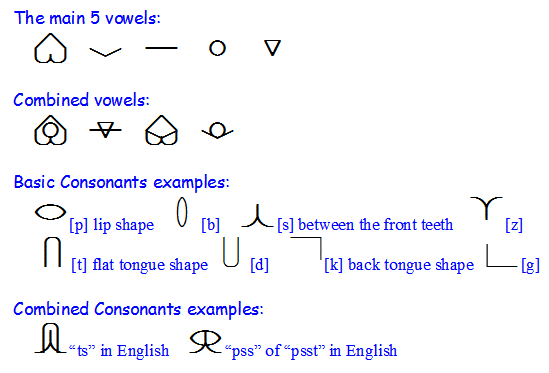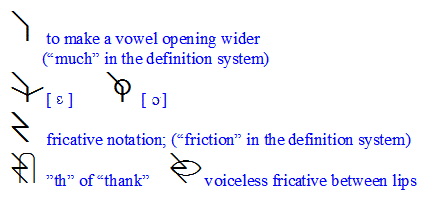
English Home,
Japanese Home
1[human, plant, heart, life]
2[the middle circle variation]
3[Relating to friends' opinions,
Between cultures, etc.]
4[phonetics]@
EL Phonetics (1) Phoneme Bases

EL has its phonetic system too, separately from the
definition system.
A vocal word is a thing to change occasionally. But
traditional alphabets and ideograms
have been used for recording both meanings
and sounds at once;
and messed up the original phonetic functions over time.
EL
phonetics express only how to reproduce an oral sound,
not only for languages
but also for any oral performances.
Normally you communicate with ideograms in
the definition system;
and for showing vocal names and specific vocal sounds,
use phonetic symbols.
EL uses a total of 50 basic phonetic symbols borrowing
them from the EL bases.
A phonetic part in a definition script is bound between
phonetic brackets.
For more about the phonetic brackets:
http://www.earthlanguage.org/english/phone/pbracket.htm
EL Phonetics (2) phoneme symbols

Basic phonemes are shown by picture-like symbols.
A basic vowel symbol is made in the image of the mouth
pronouncing it.
A basic consonant
symbol
is a simplified shape of the main oral organ
pronouncing it,
or the direction/movement of the air stream for the sound.
The
similar shapes share the similar phonemes. They share a key of a keyboard too.
When a pronunciation is a combination of basic phonemes,
it is shown by the
overlay of the features of those bases.
More about vowels:
http://www.earthlanguage.org/english/phone/vowel.htm
The manner of the articulation:
http://www.earthlanguage.org/english/phone/tech.htm
More about EL consonant:
http://www.earthlanguage.org/english/phone/conson.htm
(You can add much more.)
We had discussed here about vowel setting before, somehow it has been deleted
though.
John Smith recommended using hertz realm to commonly distinguish vowels.
I think itfs a rational idea for the detail.
EL Phonetics (3) additional notations/diacritics

EL uses additional notations/diacritics to change an original manner of
articulation of a phoneme,
overlaying on top of a phoneme symbol, such as to
make an articulation place inner or outer,
its opening larger or smaller.
For
these notations, each similar meaning base in the definition system to
its phonetic function is used.
So, you need not make much effort to learn them.
More about Diacritics:
http://www.earthlanguage.org/english/phone/function.htm
EL consonant table:
http://www.earthlanguage.org/english/phone/table.htm
EL Phonetics (4) Time order
An EL phonetic script arranges phoneme-symbols from the left to the right in
time order.
Time Order is an important rule to show how to reproduce an oral sound.
Overlaid
bases have to work together at once, and when the articulation shifts,
you need
to show the phonemes separately.
Try to pronounce a syllable [ho]. Can you make
the sound [h] before [o]?
No you canft. Alphabet uses two letters for the sound,
but EL shows one symbol,
differently from [po] which shifts from [p] to [o].

Chinese, Korean, Japanesec many languages uses syllabic characters; and the
people in those traditions
might think syllabics could be much easier to use
than time order.
If you create the kind of new system using EL Font, please make
a logo for the system;
and put it in the phonetic brackets to bind the phonetic
part of your style.
Otherwise the reader could get confused.
Some languages use long syllables.
For example, gscrollsh and gscriptsh in
English are single syllables.
If you overlay six phonemes into one for them, can
you figure out how to pronounce them?
EL is set to work globally. Time order is
the simplest rule for the common purpose.
EL Phonetics (5) Various Pronunciations
EL Phonetics can express a variety of oral sounds, including some oral clicks,
ejectives,
throat song pronunciations, sometimes with accents, pitches and
rhythms.
If you make a record of your partnerfs snoring sound, it might work for
his/her medical check.
Wouldnft you like to create a vocally funny song without
any meaning using EL phonetics?
If you create some, please share it here.
Some examples of EL phonetics usage:
http://www.earthlanguage.org/english/phone/example.htm